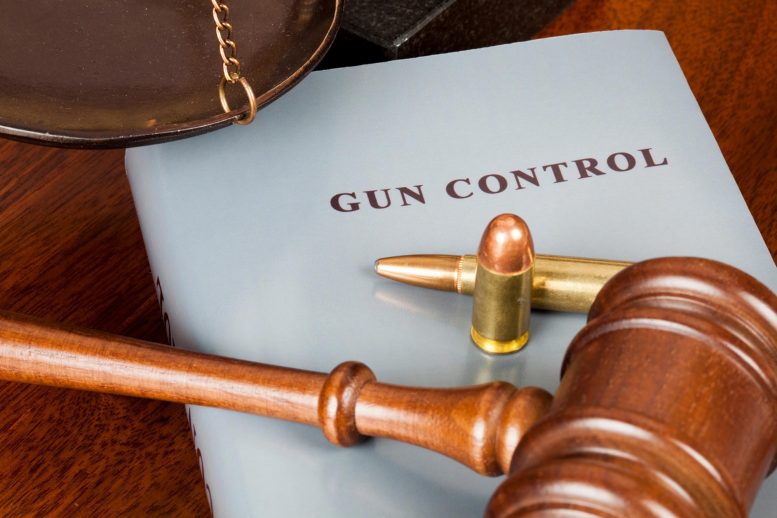
Research on the impact of gun legislation has produced mixed results, and the effectiveness of Massachusetts’ law remains uncertain.
Researcher suggests lawmakers ensure measure is being implemented as intended.
Although many Americans favor expanding background checks for gun purchases, gun-control measures in Congress have failed to garner enough votes to pass. In contrast, some state legislatures have enacted measures to reduce gun violence in their communities. A new study examined the impact changes to background checks and licensing policies have made on different types of violent crime in Massachusetts. The study found no immediate impact, suggesting that state lawmakers may want to ensure their legislation is being implemented as intended.
The study, by a researcher at American University (AU), appears in Justice Quarterly, a publication of the Academy of Criminal Justice Sciences.
“Gun violence remains at the forefront of the public policy debate when it comes to enacting new or strengthening existing gun legislation in the United States,” explains Janice Iwama, assistant professor of justice, law, and criminology at AU, who conducted the study. “Yet the political polarization and relatively limited scholarly research on guns and gun violence make it difficult for policymakers and practitioners to enact and implement legislation that addresses the public health and safety issues associated with gun violence.”
In 2014, Massachusetts passed new requirements related to background checks for firearms sold at gun shows or through private sales and created changes to firearm regulations by adopting new gun licensing procedures; the new law went into effect in January 2015. Research on the effects of gun legislation has yielded mixed findings and the effectiveness of Massachusetts’ law is unclear.
Iwama explored the differential effects of the new legislation on public safety outcomes, including violent crime, in Massachusetts counties from 2006 to 2016. She used data from the Firearms Records Bureau, a statewide agency that maintains a database of issued licenses and records of firearms sales by gun dealers, as well as private transfers of weapons.
The study used models to predict counts of violent crimes, using data from the FBI, and considering variables that represent the percentage of all denied applications, the percentage of denied applications due to unsuitability, and the percentage of denied applications due to statutory disqualification (e.g., criminal history record, mental health record, fugitive status) at the county level.
Based on the percentage of firearms licenses, about 1 to 5 percent of adult residents had a firearms license in Massachusetts counties. But Iwama found no consistent effect of the new legislation on reducing four types of violent crime (murder or nonnegligent manslaughter, aggravated assault, robbery, rape). Her study did find that a one-percent increase in denied firearm licenses and denied firearm licenses following statutory disqualifications increased robberies by 7.3 and 8.9 percent, respectively.
While the percentage of denied firearms licenses and firearms license applications had little to no effect on violent crimes, Iwama suggests state lawmakers revisit their legislation to ensure that it is being implemented as intended and address the challenges identified. In particular, are these findings the result of a longer-than-expected lag in enforcement following the passage of the legislation? Are they due to individuals obtaining firearms in nearby states with looser gun laws? Or is it possible that the 2014 law is being enforced differentially by county?
“It is important for policymakers, practitioners, and researchers to consider the magnitude of effects of their laws and how they may be influenced by different levels of enforcement in the state or by the lack of enforcement in surrounding states,” cautions Iwama.
Among the study’s limitations, Iwama notes that the data collected from the FBI was not complete because of changes in reporting practices. In addition, the percentage of firearms licenses, which she used as a proxy for gun ownership, represents neither a perfect measure of gun owners nor an accurate count of the number of firearms available by county. Finally, the small size of the study’s sample hindered the author’s ability to examine patterns across different counties in the state.
Reference: “Reducing Violence?: Examining the Impact of Gun Control Legislation in Massachusetts” by Janice Iwama, 21 October 2021, Justice Quarterly.
DOI: 10.1080/07418825.2021.1985593









“Yet the political polarization and relatively limited scholarly research on guns and gun violence make it difficult for policymakers and practitioners to enact and implement legislation that addresses the public health and safety issues associated with gun violence.”
It is true that there is considerable political polarization, although there is no shortage of published, scholarly research. However, much of that research has been so biased and of such poor quality that Congress passed a law forbidding federally funded research that promoted gun control.
Federal gun control laws are uniform across the country, and state laws are very similar in most states. Yet, there are significant geographical clusters of homicides indicating that it isn’t the presence of firearms or the supposed weakness in gun control laws that are responsible for criminal firearm violence. Instead, it is cultural differences and population densities that play a significant role. Firearm homicides are overwhelmingly committed by young males, most of whom cannot legally own firearms either because of their age or their criminal record. Yet, they get them. If they didn’t get them locally, the drug cartels would quickly take advantage of a ready market and supply them to add to their illicit-drug profits.
Vermont has very lax gun control laws and little problem with firearm homicides. New York and Massachusetts have very restrictive laws, yet they have serious problems with firearm homicides. Assuming for the sake of the argument that the people in New York and Massachusetts feel more of a need for restrictive laws, it begs the question of why that is when nearby Vermont doesn’t.
There is an old saying that “The road to Hell is paved with good intentions.” Most gun control laws are examples of that. They are often unenforceable, or unenforced, and don’t address the singularly most important problem that criminals don’t obey the law. Gun control laws are most effective with law-abiding people.
Those who focus on the inanimate object that results in the loss of life are myopic and have failed to learn from the past. The recent tragedy on the film set of Rust, points out clearly that it is human fallibility that is responsible for deaths. We don’t discourage driving cars in the hope that we will reduce vehicular deaths! We try to change the behavior of drivers with education and enforcement.
Amen Clyde! One possibility that never seemed to occur to these researchers was that the legislation was useless in the first place.
The answer is so obvious. To anyone with a brain, that is.
Those places that have disarmed the Citizens have the most crime.